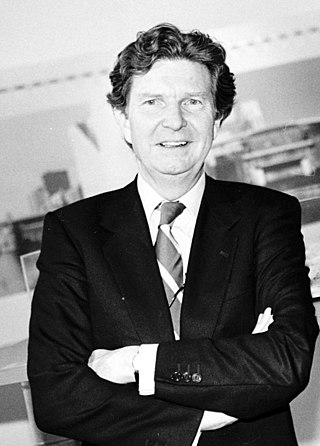
Rotterdam is the second-largest city in the Netherlands after the national capital of Amsterdam. It is in the province of South Holland, part of the North Sea mouth of the Rhine–Meuse–Scheldt delta, via the "New Meuse" inland shipping channel, dug to connect to the Meuse at first and now to the Rhine.

Rozenburg is a town and former municipality in the western Netherlands, in the province of South Holland. The municipality had a population of 13,173 in 2004, and covers an area of 6.50 km². It was the second-smallest municipality in the Netherlands in area. On 10 July 2008, the local council decided to disband the municipality and to form a submunicipality of Rotterdam. This was ratified on 27 October 2008 by the Eerste Kamer, and came into effect on 18 March 2010.

Oscar Ignatius Joannes van Dillen is a Dutch composer, conductor, and instrumentalist.

Stadion Feijenoord, more commonly known by its nickname De Kuip, is a stadium in Rotterdam, Netherlands. It was completed in 1937. The name is derived from the Feijenoord district in Rotterdam, and from the amateur club with the same name.

Municipal Museum Boijmans Van Beuningen is an art museum in Rotterdam in the Netherlands. The name of the museum is derived from the two most important collectors of Frans Jacob Otto Boijmans and Daniël George van Beuningen. It is located at the Museumpark in the district Rotterdam Centrum, close to the Kunsthal and the Natural History Museum.

The Port of Rotterdam is the largest seaport in Europe, and the world's largest seaport outside of East Asia, located in and near the city of Rotterdam, in the province of South Holland in the Netherlands. From 1962 until 2004, it was the world's busiest port by annual cargo tonnage. It was overtaken first in 2004 by the port of Singapore, and since then by Shanghai and other very large Chinese seaports. In 2020, Rotterdam was the world's tenth-largest container port in terms of twenty-foot equivalent units (TEU) handled. In 2017, Rotterdam was also the world's tenth-largest cargo port in terms of annual cargo tonnage.

Katendrecht is a neighbourhood of Rotterdam, on the south bank of the Nieuwe Maas. It is located between the Rijnhaven and the Maashaven. Katendrecht was a separate municipality from 1817 to 1874, when it merged with Charlois.

Museumpark is an urban park in Rotterdam, Netherlands, located between the Museum Boijmans Van Beuningen, Westersingel, Westzeedijk and the complex of the Erasmus MC, a medical centre affiliated with the Erasmus University.

Willemsoord is a large former naval base of the Royal Netherlands Navy in Den Helder. It is now connected to the city center of Den Helder, and focuses on entertainment and tourism.

The Nieuwe Maas is a distributary of the Rhine River, and a former distributary of the Maas River, in the Dutch province of South Holland. It runs from the confluence of the rivers Noord and Lek, and flows west through Rotterdam. It ends west of the city where it meets the Oude Maas, near Vlaardingen, to form Het Scheur. After a few miles, the Scheur continues as the artificial Nieuwe Waterweg. The total length of the Nieuwe Maas is approximately 24 kilometres (15 mi).

The Maastoren is with its height of 165 metres the second tallest building in the Netherlands. The office building is situated on the bank of the Nieuwe Maas, after which the building is named, in the neighborhood Kop van Zuid in the South Holland city of Rotterdam. The Maastoren was built between 2006 and 2009, and had OVG as its developer. The Maastoren has a total of 44 above ground floors and two underground floors.
The World Port Days, also known as the World Harbour Days, is a large, festive maritime event held annually in Rotterdam. It is one of the most highly attended events in the Netherlands.

Noordereiland is a neighborhood of Rotterdam, Netherlands. The Noordereiland owes its name to the Noorderhaven which, under the leadership of C.B. van der Tak was dug between 1872 and 1874. By digging the Noorderhaven, the Noordereiland was separated from the former island of Fijenoord and is now an island between the central parts of the North and South side of the city. Until the end of the 20th century the island was inhabited by a large population of inland skippers. Part of the neighborhood is a protected cityscape.
Alliance Gastronomique Néerlandaise is a culinary association of quality restaurants in the Netherlands and Flanders.

Hubert-Jan Henket is a Dutch architect. He is a specialist in the relations between old and new buildings, the redesign of buildings, renovation and restoration. He is the founder of DOCOMOMO international.
De Brave Hendrik was a fine dining restaurant in Hendrik-Ido-Ambacht, Netherlands. It was awarded one Michelin star in 1990 and retained that rating until 1996.
The following is a timeline of the history of the municipality of Rotterdam, Netherlands.

Dora Dolz de Herman was a Spanish-Dutch artist, best known for her outdoor ceramic works in the form of chairs and sofas.

Nieuwe Instituut is a cultural centre in Rotterdam, the Netherlands. It focuses on architecture, design, and digital culture. NI is in a building designed by Jo Coenen at Museumpark 25 in the centre of Rotterdam, adjacent to the Museum Boijmans Van Beuningen. The building contains a shop, exhibition space, study centre, and archive, as well as the Sonneveld House, a pond, and a small park.





















